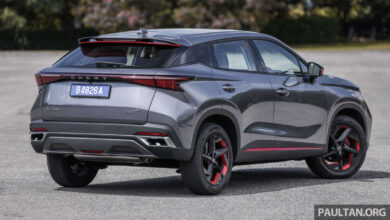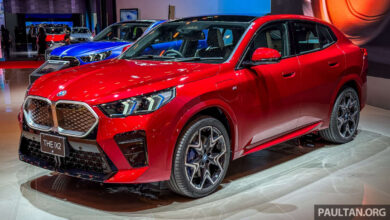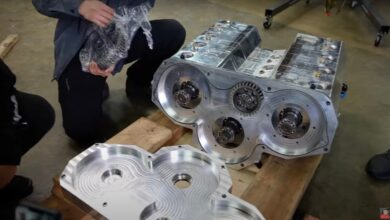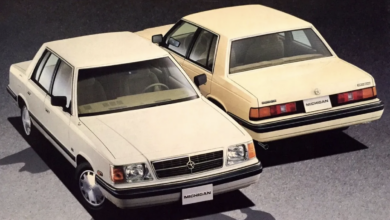Could hydrogen be the green future for motorcycling? A deep dive…
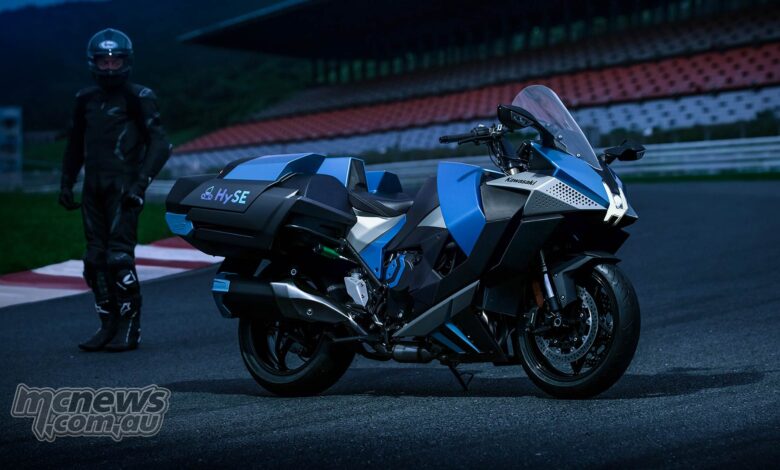
Could hydrogen be the green future for motorcycling?
The Japanese automotive industry seems to think so…
While American, Chinese, and many European manufacturers are focussed on battery technology to achieve an environmentally friendly future for motorcycling, Japanese brands have been quite steadfast in their commitment to developing hydrogen as a viable alternative.
The challenges are immense, but if those difficulties relating to hydrogen production, transport and storage could be overcome, it would be a huge step forward. However, many doubt that hydrogen can be made truly viable.
Hydrogen takes a fair bit of energy to produce, which can potentially be achieved through solar and wind, but perhaps it is nuclear energy that the Japanese are looking towards powering this revolution.
While Japan became an industrial powerhouse during the previous century, it has always been a net importer of energy. Japan has very few natural resources. In fact, Australia currently supplies around 70 per cent of Japan’s coal and 40 per cent of its gas.
Until 2011, Japan generated 30 per cent of its electricity needs from nuclear power and had set a target to increase that capacity to 41 per cent by 2017, and achieve 50 per cent nuclear generation by 2030. However, the natural disaster that caused the incident at Fukushima in 2011 saw Japan shut down much of its nuclear industry.
Since then, Japan has been slowly turning back to nuclear energy. 12 reactors have been brought back online, and a further 13 are in various states of preparation for returning to the grid.
However, despite having two new reactors under construction, Japan is not pursuing nuclear power as aggressively as it once was. The current government aims for 20-22 per cent of its energy needs to be met by nuclear reactors by 2030, less than half of the target it stated in 2011.
Okay, I know we are supposed to be talking about motorcycles, but my reasoning here is in the search for an explanation why, despite its significant challenges, the Japanese automotive and motorcycle industry still see hydrogen as a potential answer over the battery powered approach which, of course, has its own set of challenges. Currently it does seem that the pursuit of hydrogen power is largely a Japanese driven approach.
Australia is dabbling with Hydrogen products, one of the biggest is led by Andrew Forrest’s Fortescue Metals powerhouse, which incidentally makes it profits primarily on the back of digging up iron ore in Western Australia and sending it to China.
The Hydrogen investments currently being pursued are generally paid for by massive government subsidies, much the same as the solar, wind and EV industries are largely government backed enterprises paid for by the taxpayer. Forrest though is one to have put a sizeable wedge of his, and his shareholders money towards what they hope might be a hydrogen powered future.

Despite a huge $2bn subsidy scheme paid for by us, Australian taxpayers, the smart minds and big bank balances of even Fortescue are having trouble meeting their targets in regards to hydrogen. Fortescue made some corporate announcements last week that dampened down their Hydrogen expectations and seemed to hint that their targets are unachievable.
The current 2024-25 Australian Government budget allocates $22 billion to help fund renewable energy. That is 22,000 million for those of us that struggle to get our head around numbers big enough to use the term billion, or in numerals, 22,000,000,000.
That is a lot of zeros. This backing is seen as a worthwhile investment in the aim of reducing carbon emissions and the effects of climate change. Obviously we are primarily talking about energy production for household and industry use, not to power vehicles. Although, of course, energy produced generated by these methods is used to charge electric vehicles.
However, in recent years, the mix of technologies providing power to Australian consumers has been primarly driven through burning fossil fuels. 68 per cent of the power output is burned into the Australian grid from 47 per cent coal, 19 per cent gas and two per cent oil.
Renewables currently account for around 32 per cent of electricity generation in Australia. Rooftop solar accounts for over 11 per cent of Australian energy production put into the grid. And, of course, pretty much every one of those millions of panels sat on Australian rooftops was made in China. How much ecological and environmental damage was done in the production, transport and installation of those panels?
Thankfully the recycling solar panels is starting to become viable rather than sending them to landfill, but we must look at the complete cycle of life when considering how energy is produced.
As in most new technologies, China is leading the way in EV production via state owned enterprises. However, China remains the largest consumer of coal in the world and uses this most carbon intensive power source to generate more than half of its energy needs. China is home to half the world’s coal fired power plants and currently burns more coal than the rest of the world combined.
Despite China also possessing the world’s largest resource of renewables and hydroelectricity, it is second only to the United States in regards to nuclear capacity, and has been named as the single largest contributor towards global gas demand.
The numbers are mind boggling. China’s total electricity consumption in 2023 was 9.22 trillion kWh. That figure is almost 50 times of our energy demand here in Australia. It really does make you wonder why anyone in the world bothers trying to be ‘green’ when confronted with such staggering numbers.
If you look at the energy needs per capita, China can be seen as ‘efficient’, with world bank data, not that I really trust that or all the other global bodies too much, but anyway, they have crunched their numbers to come up with an electricity consumption per capita of 3905 kWh for China’s 1.412 billion people. The same source states a demand of 12,994 KwH for America’s 333 million humans. Australia is not far behind at just over 10,000 kWh for each of our 26 million habitants. However, it doesn’t take a genius to work out that the more people you squeeze into small spaces, who also generally don’t travel too far for work, equates to less overall power demand per person.

Anyway, back to motorcycles…
Back to motorcycles… I diverged into talking about the energy mix there as no matter what fuel is used to power our vehicles, be that battery, hydrogen, or petrol, they all take energy to make. It also takes energy and resources to make batteries, to make solar panels, or to make nuclear powerplants.
The idea is to make the end quotient as beneficial as possible.
And if Japan are pursuing hydrogen powered vehicles, I would assume they will use nuclear energy to produce that hydrogen. I expect they are taking that route because Japan is so reliant on imports from overseas to meet their energy demands. They are smart enough to know that they must strive to move the dial of self sufficiency back in their favour. One would say it is imperative for the long-term survival of the nation and any chance of prosperity for its people. The same reasoning should apply here, but I am not going to hold my breath on that one…

Last week in Japan, Kawasaki used the Suzuka 8 Hour event to demonstrate a hydrogen powered prototype in front of a public audience for the first time.
This was not some boring commuter motorcycle, but a large sports-touring style machine powered by a hydrogen powered version of Kawasaki’s flagship supercharged H2. Now that is how to get our attention!
The 998 cc in-line four was modified to allow direct injection of hydrogen fuel into the cylinders while the chassis was designed to accommodate hydrogen fuel tanks.
Of course the pipe dream is to achieve levels of purity from an internal combustion engine that it only emits rainbow coloured fairy farts, and the Hydrogen powered motorcycle comes mighty close! The primary emission from the Kawasaki prototype is water in the form of steam. Of course, as oil is still used as the primary lubricant, a miniscule amount will be burnt and released into the atmosphere.
Satoaki Ichi, project leader for Kawasaki, calls it ‘a humidifier on wheels’. Ichi-san also admits that they ‘are still at the basic research stage.’ However, they are up and running…

Some of the primary challenges with any shift to Hydrogen is in the storage, transport and end-user supply of the Hydrogen itself. These are some major hurdles with Hydrogen said to be much more susceptible to leaks when piped, in comparison to LPG or liquid based fuels. Hydrogen is also much more flammable than conventional fuels.
The fact that it is also colourless and odourless would mean that any filling station would have to be tightly controlled via sensors that would detect the slightest leak and shut off supply.
Despite its environmentally friendly nature, Hydrogen will ignite much more easily than petrol. When hydrogen does burn, it does so with virtually no visible flame in daylight.
It is not all bad news though as Hydrogen also has some clear advantages, the fact that it is non-toxic being the highest of all.
That hydrogen is so easily ignited will also deliver gains in engine response and require a less powerful ignition system.
Hydrogen has three-times the energy content of petrol. However, on a volume basis, the advantage is reversed, as petrol is four-times as dense and thus much more easily transported and stored.

Thus we end up with the same dilemma that battery motorcycles do, where to put the fuel…?
Here Hydrogen does provide some flexibility over EV. Hydrogen’s light weight means it can be put in various places on the motorcycle without completely ruining its dynamics.
EV batteries, due to their weight, need to be placed low and central to achieve a reasonable centre of gravity.
On the other side of the coin, much has been made of runaway lithium battery fires, but I imagine the bang when a tank of hydrogen is breached through impact would be something to behold..?
Refuelling times would tip the scales back in favour of Hydrogen over waiting for your batteries to charge. However, once out of the major cities access to charging points is already a problem for many EV users. This remains today despite the many years EVs have been on the road and the increasing uptake by the public. Hydrogen would start from zero, as I can’t remember the last time I saw somewhere to recharge my hydrogen tank…

Refuel times would be their primary benefit in comparison to EV charge times.
Oh, and here is a motorcycle that won’t make your bum look big..
A major advantage of the hydrogen approach is that the significant efficiency advantages in internal combustion engine design realised in recent decades can also put to be good use when hydrogen is used as a fuel.
A further upside is that the use of hydrogen in these engines can see manufacturers realise the space gains made by no longer requiring catalytic convertors, of which a lot of modern motorcycles require two of in order to meet the latest emissions standards. Cats also require special metals to make and there is an environmental impact to be considered there also.
In automotive use hydrogen power could also negate the need for the complicated EGR systems which in high performance applications can be prohibitively expensive to service. Once the vehicle has been in use for some time, often EGR and other emissions related controls end up making the vehicle less efficient than they would be if they never had them in the first place. This is what happens in the real world.

Apart from tweaks to the fuel delivery system, and the need for somewere to store the hydrogen fuel on the vehicle, current manufacturing methods, supply chains and production lines can all be used to produce hydrogen powered vehicles. And for many of us, the fact that they still provide the visceral sound and feel we have grown to love is a massive plus.
The various and major challenges of using hydrogen as a power source have not stopped the big four Japanese motorcycle manufacturers making significant investments in researching a solution to the problems.
Kawasaki, Honda, Yamaha and Suzuki formed an alliance last year where they took on shared duties in the quest to make hydrogen a viable alternative to power them into the future. I covered that announcement in some detail here (Link).
This alliance, created in May 2023, is called HySE (Hydrogen Small mobility & Engine technology).

HYSE – The role of each company
Honda has been tasked with research on the model-based development of hydrogen-powered engines.
Suzuki will focus an element study on functionality, performance, and reliability of the hydrogen-powered engines.
Hands-on research using real hydrogen-powered engines on their functionality, performance, and reliability will be conducted by Yamaha and Kawasaki.
Yamaha are also tasked with studying the requirements for a hydrogen refueling system and hydrogen tanks for small mobility.
Kawasaki will take the lead in studying the auxiliary equipment required for a fuel supply system and tanks, and the equipment installed between the fuel tank and the injector.
In addition to the full members Kawasaki Heavy Industries and Toyota Motor Corporation support the association as special members.
Kawasaki Heavy Industries are already one of the main organizers of the “CO2-free Hydrogen Energy Supply-chain Technology Research Association” and will help drive forward HySE’s activities, based on the knowledge gained from its activities.
Toyota, on the other hand, will assume the role of leveraging HySE’s research results to the maximum benefit for the development of hydrogen-powered engines, utilising its know-how on experiments, analyses, and the designing of large hydrogen-fueled power units for four-wheel vehicles.
Yamaha have also produced a hydrogen-fuelled V8 for Toyota that makes 450 horsepower (Link).
Clearly, the Japanese automotive industry are more deeply investigating hydrogen than any other.
The Japanese car industry also seems more firmly wed to hybrids over the completely EV alternative. Perhaps hydrogen powered hybrids might be the way of the future? Kawasaki have also broke ground here and stated that they plan to have ten battery and hybrid powered vehicles in the market by 2025.

Much smarter minds than you or I don’t really have the definitive solution yet.
However, I am pleased that they are working on the alternatives and will happily cheer them all on from the sidelines, and will just as happily ride whatever variations they produce. And pull wheelies on them..
What say you..? As I am sure many of you out there are more across these subjects than I… If you have something genuinely education and objective to add to this conversation I invite you to email me to consider for publication here. Alternatively, you can also contact me off the record.
